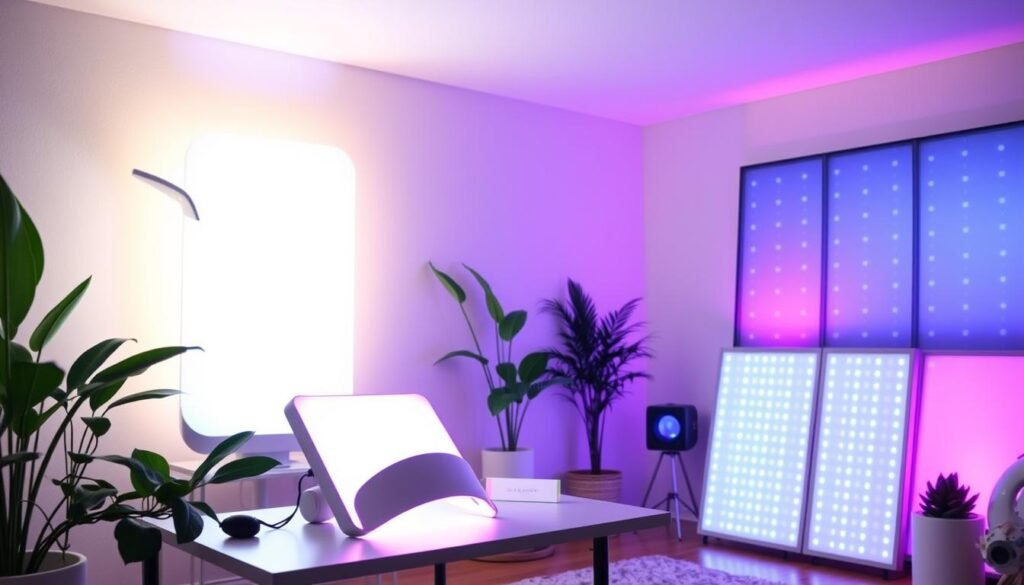Did you know that around 350 million people globally suffer from depression? This fact has led researchers to look for different treatment methods. Light therapy for depression and anxiety is one such approach that’s gaining attention. It’s showing promise in easing mood disorder symptoms, especially in those with Seasonal Affective Disorder (SAD) and different kinds of non-seasonal depression.
About 60% of people who end their lives wrestle with depression. This makes finding effective treatments essential. More and more research is supporting phototherapy as a valuable option alongside traditional therapies.
Key Takeaways
- Light therapy is effective for both Seasonal Affective Disorder and non-seasonal depression.
- Studies suggest a standardized mean difference in depression scores of -0.41, indicating beneficial effects.
- Around 50-60% of patients respond to first-line depression treatments, emphasizing the need for alternatives like light therapy.
- This treatment method has minimal side effects compared to conventional drugs.
- Significant mood improvements can occur with just 40 minutes of exposure to specific light intensities.
What is Light Therapy?
Light therapy is also known as bright light exposure therapy. It helps with mood disorders. It uses lamps that mimic sunlight. This makes brain chemicals better, helping those with seasonal affective disorder (SAD) and depression.
Definition and Overview
This therapy uses light boxes daily, with about 10,000 lux brightness. This light engages the mechanism of light therapy in the brain. It helps regulate sleep and improves mood.
How It Works
Light therapy resets our body’s clock, which can get off track when sunlight is scarce. Using a therapy lamp, people feel better with regular use. To feel the benefits, 30 minutes of morning light therapy is best during winter.
Benefits for Mental Health
Studies show light therapy benefits mental health by boosting mood and energy. It also lowers anxiety and depression symptoms. Bright light therapy is a top choice for treating SAD. It’s easy to use and safer than some medications.
Adding phototherapy for mental health is good for more complete care. Despite its many benefits, get a doctor’s advice before starting light therapy.
Understanding Seasonal Affective Disorder (SAD)
Seasonal Affective Disorder, known as SAD, affects people mostly in winter. This is when there’s less daylight. Those with SAD may feel very sad, have less energy, and struggle with their mental health.
Symptoms and Causes
Symptoms of SAD include:
- Feeling sad
- Having little energy
- Getting easily upset
- Problems with sleeping
- Gaining weight
The main cause of SAD is not getting enough natural sunlight. This messes with our body clocks and lowers serotonin. About 10-20% of people might have mild SAD symptoms. Women get it more often than men. SAD usually starts in young adulthood and can last 4-5 months every year.
Statistics and Prevalence in the U.S.
About 5% of Americans have SAD, especially in places like Alaska or New England where winters are dark. Key facts about SAD include:
| Statistic | Details |
|---|---|
| Occurrence | Affects about 5% of the U.S. population |
| Gender Disparity | More common in women |
| Onset Age | Tends to start in young adulthood |
| Duration | Symptoms last around 4-5 months a year |
| Co-occurrence | Seen more in those with depression or bipolar disorder |
Since the 1980s, light therapy has been a top treatment for winter SAD. Knowing these facts and how it affects people is key to dealing with SAD.

Light Therapy for Depression and Anxiety Treatment
Light therapy is key for helping with mood problems, especially when seasons change how we feel. It works by adjusting serotonin and sleep, which makes us feel better. It’s known to help lessen anxiety and depression.
Mechanism of Action
Light therapy helps by affecting serotonin, crucial for mood balance. Bright light in therapy can decrease melatonin and boost serotonin. This helps stabilize mood, making the treatment good for anxiety. It’s best to have therapy in the morning for quick improvements, often seen in a week.
Effectiveness for Various Mood Disorders
Studies show light therapy works well for seasonal depression (SAD) and may help with general anxiety too. It’s effective for major depression, useful in seasonal and non-seasonal cases. Regular light exposure can stabilize mood, boosting emotional health.

If light therapy interests you, looking into trusted resources can offer more information. Tailoring it to your needs can better help anxiety and mood issues, leading to better emotional health.
Types of Light Therapy Devices
There are different light therapy devices, each aimed at specific health needs. Light boxes, dawn simulation devices, and light visors offer varied benefits. These options help people dealing with Seasonal Affective Disorder (SAD) and depression.
Light Boxes
Light boxes are popular for light therapy. They shine bright at 10,000 lux and come in many shapes for anywhere use. It’s important to stay 16 to 24 inches away to get the most out of them.
Models like NorthStar and SunRay II are great because they screen out UV light and are bright enough for SAD. For best results, use these boxes for 30 minutes every morning.
Dawn Simulation Devices
Dawn simulation devices gently increase light like the sunrise. This helps those who struggle to wake up or need to fix their sleep schedules. They complement light boxes well, making mornings easier.
Light Visors and Other Options
A light visor for depression is made to wear on your head, shining light into your eyes. They’re portable, but we don’t know as much about them as we do about light boxes. There are also other devices aimed at easing SAD symptoms.

| Type of Device | Lux Output | Best For | Recommended Usage |
|---|---|---|---|
| Light Boxes | 10,000 lux | SAD treatment | 30-60 minutes in the morning |
| Dawn Simulation Devices | Variable, starting low | Sleep regulation | Use upon waking |
| Light Visors | Variable | Portable therapy | As needed |
Choosing the Right Light Therapy Lamp
Choosing the right light therapy lamp matters a lot if you’re treating mood disorders. It’s key to look at light therapy features. You want a lamp that meets your specific needs.
Key Features to Consider
When picking out a light therapy lamp, make sure to check certain features:
- Intensity: Aim for lamps with 10,000 lux. That’s the best level for treatment.
- Size: How big the lamp is can influence how you use it and where.
- UV Filtering: Go for lamps that keep out harmful UV rays. This makes light therapy safer.
- Design: Look at cool extras like wireless charging and USB ports.
Recommended Brightness Levels (Lux)
Knowing about light therapy brightness levels is key. The best therapy lamps are much brighter than normal indoor lights. Normal rooms are about 100 lux bright. Sunlight, though, can hit 50,000 lux. So, a good therapy lamp should give off:
| Type of Lamp | Distance (inches) | Brightness Level (Lux) |
|---|---|---|
| Medical Grade SAD Lamp | 12 | 10,000 |
| Health/Wellness Grade SAD Lamp | 10 | 10,000 |
| Standard Indoor Light | N/A | 100 |
Safety Considerations
Light therapy safety should not be overlooked. Picking lamps with good UV filtering is key to protect your skin and eyes. If you have eye issues or sensitive skin, talk to a doctor first. This way, you can enjoy the benefits while keeping safe.
Combining Light Therapy with Other Treatments
Using light therapy with other treatments helps a lot with Seasonal Affective Disorder (SAD) and mood disorders. It works better than just one treatment on its own. We’ll talk about how antidepressants and psychotherapy play a part in this mix.
Role of Antidepressants
Antidepressants are important in treating depression, especially for those with severe symptoms. They work well with light therapy, especially selective serotonin reuptake inhibitors (SSRIs). A study shows mixing light therapy and medicine helps a lot with SAD. Timing the light exposure and medications right improves their effect. So, it’s important to talk to doctors about mixing light therapy and medications to be safe and get the best results.
The Importance of Psychotherapy
Psychotherapy, and especially cognitive-behavioral therapy (CBT), is key in dealing with mood disorders like SAD. It helps by changing thinking patterns that lead to depression. This gives people tools to handle their symptoms well. When you add psychotherapy to light therapy, you get a strong way to fight mood disorders. This method helps many people feel better for a long time. By using different treatments together, patients stand a better chance against their mood disorders.
Potential Side Effects of Light Therapy
Light therapy can be good for treating depression and anxiety. But, it has possible side effects to think about before starting. Knowing about these side effects can make therapy safer and better.
Common Side Effects
Here are some light therapy side effects:
- Headaches during or after therapy sessions.
- Eyestrain for those sensitive to bright light.
- Feeling more irritable or agitated.
- Problems sleeping if therapy is close to bedtime.
- Feeling tired in the morning because of changes in sleep patterns.
These side effects often go away with some changes to the therapy. For example, take short breaks or change how close you are to the light to feel better.
Who Should Avoid Light Therapy?
Some people should not use light therapy unless a doctor says it’s okay. These include:
- People with eye problems like glaucoma.
- Those on certain medicines that make them more sensitive to light.
Talking to a doctor is key to staying safe when using light therapy. This is especially important for those with other health conditions. For more information, check out this resource. It also talks about natural ways to deal with anxiety that could lower side effects.
Real-life Success Stories
Many people have seen big changes in their mental health from light therapy. It matches what scientific studies show. Such studies back up light therapy’s ability to better moods and boost energy. This is especially true for those fighting seasonal affective disorder (SAD) and other mood issues.
Clinical Studies Supporting Efficacy
Studies on light therapy show its strong impact. They often look at those who use light boxes early in the day. These people see a big drop in depression symptoms. The mix of natural sunlight and artificial light helps many. It’s especially helpful during short daylight months for those with SAD.
Personal Testimonials
People who use light therapy share its benefits on their lives. They notice a big shift in mood and behavior. These stories include getting back to daily tasks, feeling less down, and overall better mental health. Their stories show light therapy’s importance in battling depression and anxiety.
Conclusion
Light therapy is a safe, non-invasive way to help people fight depression and anxiety. It’s especially good for those with Seasonal Affective Disorder (SAD). This therapy uses fake natural light to help control mood-related chemicals in the brain. It often brings major relief from mood disorders.
Light therapy has shown to be great in dealing with many issues, like major depression and bipolar disorder. It’s even used for ADHD. The way it works varies from person to person, but research keeps revealing more about its benefits. It’s important for those interested to talk with their doctors for a personal plan.
For anyone drowning in the struggle with mood disorders, light therapy could be a beacon of hope. It’s key in achieving better mental health and dealing with SAD effectively. To boost mental wellness further, individuals can look into additional options like Cognitive Behavioral Therapy.